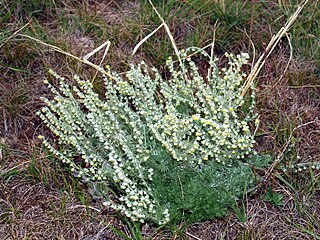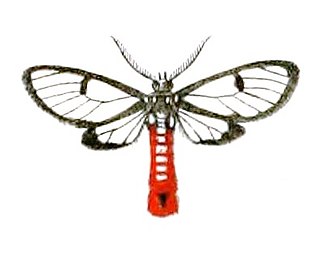Related Research Articles

An inversion is a chromosome rearrangement in which a segment of a chromosome is reversed end to end. An inversion occurs when a single chromosome undergoes breakage and rearrangement within itself. Inversions are of two types: paracentric and pericentric.

In molecular genetics, a repressor is a DNA- or RNA-binding protein that inhibits the expression of one or more genes by binding to the operator or associated silencers. A DNA-binding repressor blocks the attachment of RNA polymerase to the promoter, thus preventing transcription of the genes into messenger RNA. An RNA-binding repressor binds to the mRNA and prevents translation of the mRNA into protein. This blocking or reducing of expression is called repression.

Clystea is a genus of moths in the subfamily Arctiinae. The genus was described by Watson in 1980.

Nitzschia is a common pennate marine diatom. In the scientific literature, this genus, named after Christian Ludwig Nitzsch, is sometimes termed Nitzchia, and it has many species described, which all have a similar morphology.

Coelopa frigida is a species of seaweed fly or kelp fly. It is the most widely distributed species of seaweed fly. It can be found on most shorelines in the temperate Northern Hemisphere. Other species of seaweed flies include Coelopa nebularum and Coelopa pilipes. C. frigida feeds primarily on seaweed, and groups of C. frigida flies tend to populate near bodies of water. Climate change has led to an increase in C. frigida blooms along shores, which creates a pest problem for human beach-goers. C. frigida is also an important organism for the study of sexual selection, particularly female choice, which is influenced by genetics.

Artemisia frigida is a widespread species of flowering plant in the aster family, which is known as the sunflower family. It is native to Europe, Asia, and much of North America. In parts of the north-central and northeastern United States it is an introduced species.
Asura frigida is a moth of the family Erebidae. It is found in India.
Clystea aner is a moth of the subfamily Arctiinae. It was described by George Hampson in 1905. It is found in Venezuela.
Clystea daltha is a moth of the subfamily Arctiinae. It was described by Herbert Druce in 1895. It is found in Pará, Brazil.
Clystea jacksoni is a moth of the subfamily Arctiinae. It was described by William James Kaye in 1925. It is found in Trinidad.
Clystea lepida is a moth of the subfamily Arctiinae. It was described by Max Wilhelm Karl Draudt in 1915. It is found in French Guiana.
Clystea leucaspis is a moth of the subfamily Arctiinae. It was described by Pieter Cramer in 1775. It is found in Venezuela, Bolivia and Brazil.
Clystea paulista is a moth of the subfamily Arctiinae. It was described by Max Wilhelm Karl Draudt in 1915. It is found in Brazil.
Clystea sanctula is a moth of the subfamily Arctiinae. It was described by Paul Dognin in 1911. It is found in Brazil.

Clystea sarcosoma is a moth of the subfamily Arctiinae. It was described by Arthur Gardiner Butler in 1876. It is found in Colombia.
Clystea serrana is a moth of the subfamily Arctiinae. It was described by Schaus in 1928. It is found in Brazil.
Clystea tenumarginata is a moth of the subfamily Arctiinae. It was described by William James Kaye in 1919. It is found in Guyana.
Bucculatrix frigida is a moth in the family Bucculatricidae. It is found in North America, where it has been recorded from the northern Rocky Mountains (Alberta) and central Alaska. It was described by G. Deschka in 1992.

Venus Frigida is a 1611 oil on panel painting by Peter Paul Rubens, now in the Royal Museum of Fine Arts Antwerp. It is one of the few works which he both signed and dated and derives its title from a quotation from the Roman playwright Terence, "sine Cerere et Baccho friget Venus" i.e. love cannot survive without food and wine). He draws Venus' crouched pose from what would later be called the Lely Venus, which he saw in the Gonzaga collection during his time in Mantua.

Coelopa pilipes is a common European species of kelp fly. It was described by A. H. Haliday in 1838. Their appearance differs greatly from that of other Coelopa flies.
References
- ↑ Beccaloni, G.; Scoble, M.; Kitching, I.; Simonsen, T.; Robinson, G.; Pitkin, B.; Hine, A.; Lyal, C., eds. (2003). "Clystea frigida". The Global Lepidoptera Names Index . Natural History Museum . Retrieved April 30, 2018.
| This Arctiinae-related article is a stub. You can help Wikipedia by expanding it. |